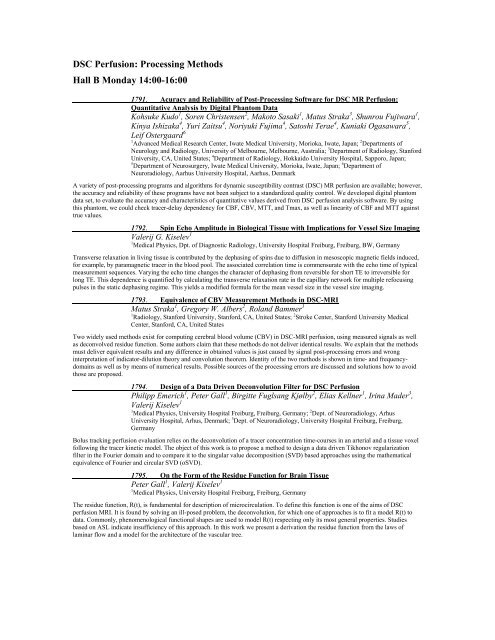Traditional Posters: Diffusion & Perfusion - ismrm
Traditional Posters: Diffusion & Perfusion - ismrm
Traditional Posters: Diffusion & Perfusion - ismrm
You also want an ePaper? Increase the reach of your titles
YUMPU automatically turns print PDFs into web optimized ePapers that Google loves.
DSC <strong>Perfusion</strong>: Processing Methods<br />
Hall B Monday 14:00-16:00<br />
1791. Acuracy and Reliability of Post-Processing Software for DSC MR <strong>Perfusion</strong>:<br />
Quantitative Analysis by Digital Phantom Data<br />
Kohsuke Kudo 1 , Soren Christensen 2 , Makoto Sasaki 1 , Matus Straka 3 , Shunrou Fujiwara 1 ,<br />
Kinya Ishizaka 4 , Yuri Zaitsu 4 , Noriyuki Fujima 4 , Satoshi Terae 4 , Kuniaki Ogasawara 5 ,<br />
Leif Ostergaard 6<br />
1 Advanced Medical Research Center, Iwate Medical University, Morioka, Iwate, Japan; 2 Departments of<br />
Neurology and Radiology, University of Melbourne, Melbourne, Australia; 3 Department of Radiology, Stanford<br />
University, CA, United States; 4 Department of Radiology, Hokkaido University Hospital, Sapporo, Japan;<br />
5 Department of Neurosurgery, Iwate Medical University, Morioka, Iwate, Japan; 6 Department of<br />
Neuroradiology, Aarhus University Hospital, Aarhus, Denmark<br />
A variety of post-processing programs and algorithms for dynamic susceptibility contrast (DSC) MR perfusion are available; however,<br />
the accuracy and reliability of these programs have not been subject to a standardized quality control. We developed digital phantom<br />
data set, to evaluate the accuracy and characteristics of quantitative values derived from DSC perfusion analysis software. By using<br />
this phantom, we could check tracer-delay dependency for CBF, CBV, MTT, and Tmax, as well as linearity of CBF and MTT against<br />
true values.<br />
1792. Spin Echo Amplitude in Biological Tissue with Implications for Vessel Size Imaging<br />
Valerij G. Kiselev 1<br />
1 Medical Physics, Dpt. of Diagnostic Radiology, University Hospital Freiburg, Freiburg, BW, Germany<br />
Transverse relaxation in living tissue is contributed by the dephasing of spins due to diffusion in mesoscopic magnetic fields induced,<br />
for example, by paramagnetic tracer in the blood pool. The associated correlation time is commensurate with the echo time of typical<br />
measurement sequences. Varying the echo time changes the character of dephasing from reversible for short TE to irreversible for<br />
long TE. This dependence is quantified by calculating the transverse relaxation rate in the capillary network for multiple refocusing<br />
pulses in the static dephasing regime. This yields a modified formula for the mean vessel size in the vessel size imaging.<br />
1793. Equivalence of CBV Measurement Methods in DSC-MRI<br />
Matus Straka 1 , Gregory W. Albers 2 , Roland Bammer 1<br />
1 Radiology, Stanford University, Stanford, CA, United States; 2 Stroke Center, Stanford University Medical<br />
Center, Stanford, CA, United States<br />
Two widely used methods exist for computing cerebral blood volume (CBV) in DSC-MRI perfusion, using measured signals as well<br />
as deconvolved residue function. Some authors claim that these methods do not deliver identical results. We explain that the methods<br />
must deliver equivalent results and any difference in obtained values is just caused by signal post-processing errors and wrong<br />
interpretation of indicator-dilution theory and convolution theorem. Identity of the two methods is shown in time- and frequencydomains<br />
as well as by means of numerical results. Possible sources of the processing errors are discussed and solutions how to avoid<br />
those are proposed.<br />
1794. Design of a Data Driven Deconvolution Filter for DSC <strong>Perfusion</strong><br />
Philipp Emerich 1 , Peter Gall 1 , Birgitte Fuglsang Kjølby 2 , Elias Kellner 1 , Irina Mader 3 ,<br />
Valerij Kiselev 1<br />
1 Medical Physics, University Hospital Freiburg, Freiburg, Germany; 2 Dept. of Neuroradiology, Arhus<br />
University Hospital, Arhus, Denmark; 3 Dept. of Neuroradiology, University Hospital Freiburg, Freiburg,<br />
Germany<br />
Bolus tracking perfusion evaluation relies on the deconvolution of a tracer concentration time-courses in an arterial and a tissue voxel<br />
following the tracer kinetic model. The object of this work is to propose a method to design a data driven Tikhonov regularization<br />
filter in the Fourier domain and to compare it to the singular value decomposition (SVD) based approaches using the mathematical<br />
equivalence of Fourier and circular SVD (oSVD).<br />
1795. On the Form of the Residue Function for Brain Tissue<br />
Peter Gall 1 , Valerij Kiselev 1<br />
1 Medical Physics, University Hospital Freiburg, Freiburg, Germany<br />
The residue function, R(t), is fundamental for description of microcirculation. To define this function is one of the aims of DSC<br />
perfusion MRI. It is found by solving an ill-posed problem, the deconvolution, for which one of approaches is to fit a model R(t) to<br />
data. Commonly, phenomenological functional shapes are used to model R(t) respecting only its most general properties. Studies<br />
based on ASL indicate insufficiency of this approach. In this work we present a derivation the residue function from the laws of<br />
laminar flow and a model for the architecture of the vascular tree.















